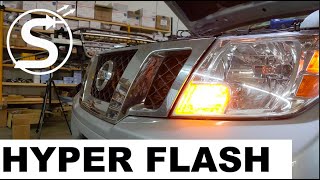Hyper flash: What is it and how do I fix it?
Hyperflash happens when you replace a standard condensed halogen bulb with an LED. In the video, you can see a standard halogen bulb and an LED bulb. You can see there is quite a difference in brightness. You can follow this pattern with the turn signals as well. The vehicle will think the turn signal is no longer working because the LEDs use less current, even when brighter, which is typically why people use LED bulbs for lighting. The reaction of the LED bulb in place of the halogen is an example of hyper flash.
The video demonstrates that the passenger side typically flashes with the regular condensed halogen bulb. When we turn on the driver-side turn signal, you can see that the light is flashing much faster. The vehicle is letting you know that the turn signal is not registering. If you are driving around using your turn signal and hear it making a fast-paced sound, you probably get a bulb out or some other problem with your turn signal.
To fix the hyper flash issue, you must place a resistor in line with the power circuit. There are three standard options to remedy the problem of hyper flash. You can get a cheap wire round resistor that usually comes in gold or green. It acts like a halogen bulb and produces extra resistance. Another good option is the Morimoto resistors. The ones presented in the video are 40 WATT; all of these will get warm to the touch. You want to mount them to a metal surface instead of plastic. Lastly, there are the Zeon depot resistors and carbon film resistors. They get less hot. Whichever resistor you use, you have to tie in across the power and ground for the turn signal.
Watch the detailed video explaining what to do and how to fix it with resistors for installation.

